Quick Start Query Analysis Using Sample Data
Tutorial Overview
Through this tutorial, you will learn how to use the built-in sample datasets of the Lakehouse platform to quickly perform query analysis using SQL without the need to prepare data in advance, thereby evaluating SQL functionality and performance.
The sample datasets are shared by the Singdata platform under the dataset named CLICKZETTA_SAMPLE_DATA, available for query by all accounts. This tutorial will use the TPC-H 100gb dataset as an example to demonstrate how to quickly complete TPC-H test set queries in Lakehouse and evaluate processing performance.
The tutorial will be completed through the following steps:
- Environment Preparation: Check the raw data using the sample dataset and create a compute cluster for testing
- Initiate Queries: Use the Studio Web environment to create SQL queries and complete 22 TPC-H SQL queries
- Change Cluster Size: Adjust the cluster size, expanding it to 4 times the previous size
- Initiate Queries: Use the resized cluster to complete the 22 TPC-H SQL queries again
- Observe the changes in query latency under different cluster specifications
Step01. Preparation
First, after logging into the Lakehouse Web console and entering the specified workspace, you can access the "Data" module to check if the relevant tables under "clickzetta_sample_data.tpch_100gb" exist in the data object list under data management.
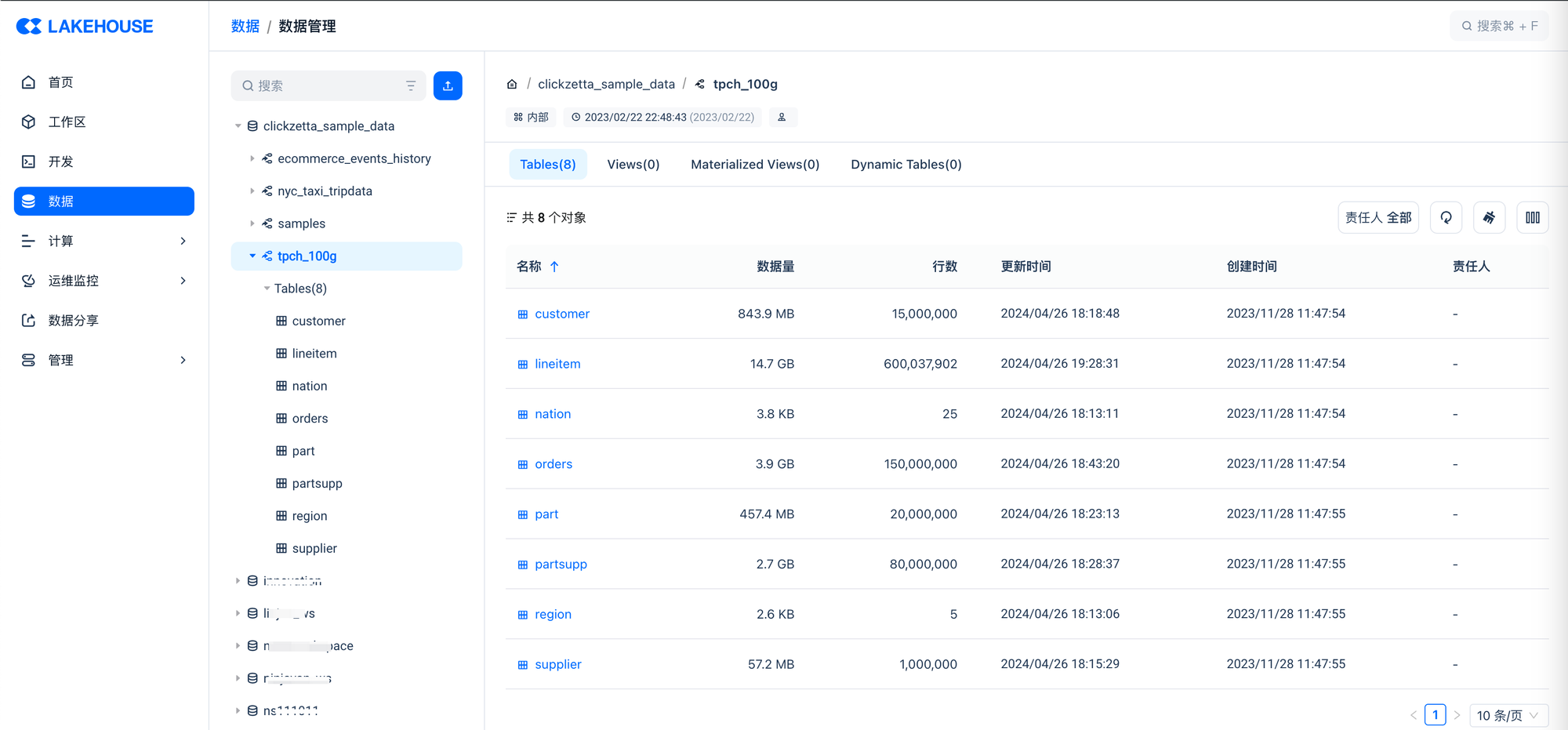
Next, we will temporarily create an independent compute cluster for query analysis for this test. You can create a new cluster through the "Compute → Clusters" menu in the Lakehouse Web console using the page wizard.
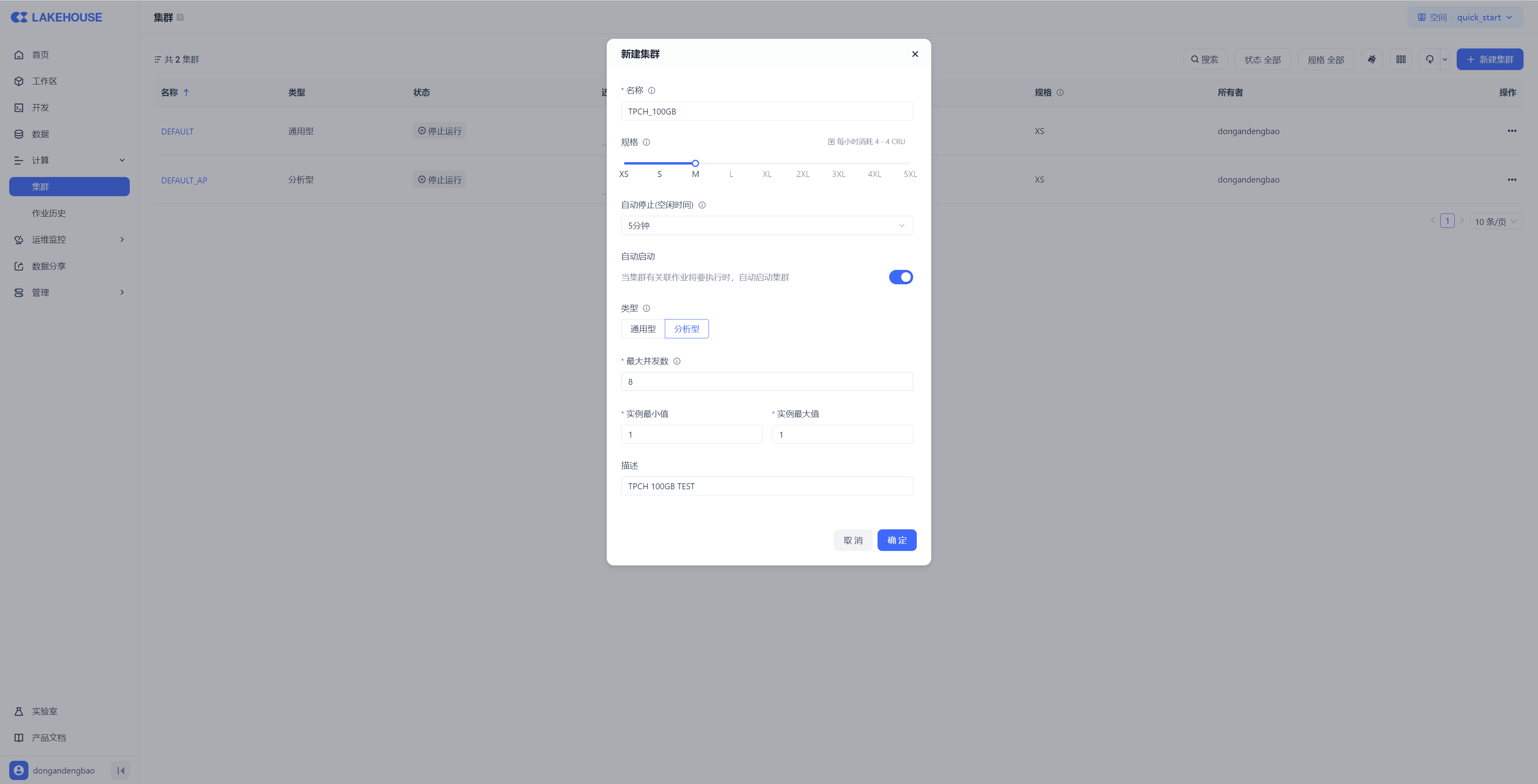
At the same time, you can also create a cluster using SQL commands. When operating with SQL commands, you can stay within the SQL development context and control cluster creation, scaling, pausing/resuming, and destruction actions through SQL commands during Ad-hoc or ETL development processes, often improving the efficiency of computing resource operations.
In this tutorial, you can quickly create a cluster by creating a new SQL script task in the "Development" module and executing the following script.
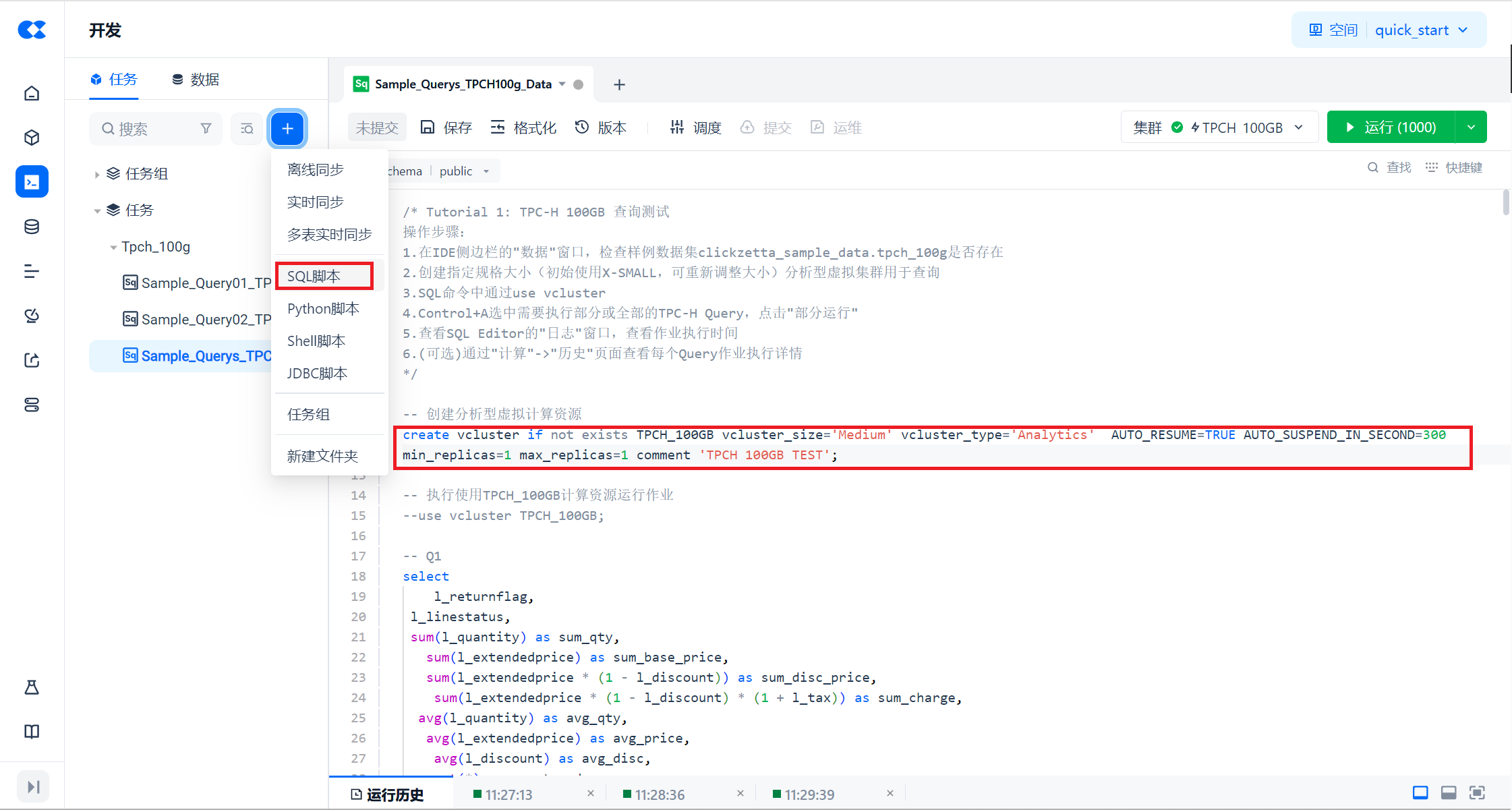
-- Create analytical virtual computing resources
create vcluster if not exists TPCH_100GB vcluster_size='Medium' vcluster_type='Analytics' AUTO_RESUME=TRUE AUTO_SUSPEND_IN_SECOND=300 min_replicas=1 max_replicas=1 comment 'TPCH 100GB TEST';
In the "Development" module, create a new SQL script task, enter the 22 TPC-H query statements, select the test cluster you just created from the "Cluster" dropdown list, then select all scripts in the task and click the "Run" button to perform serial queries.
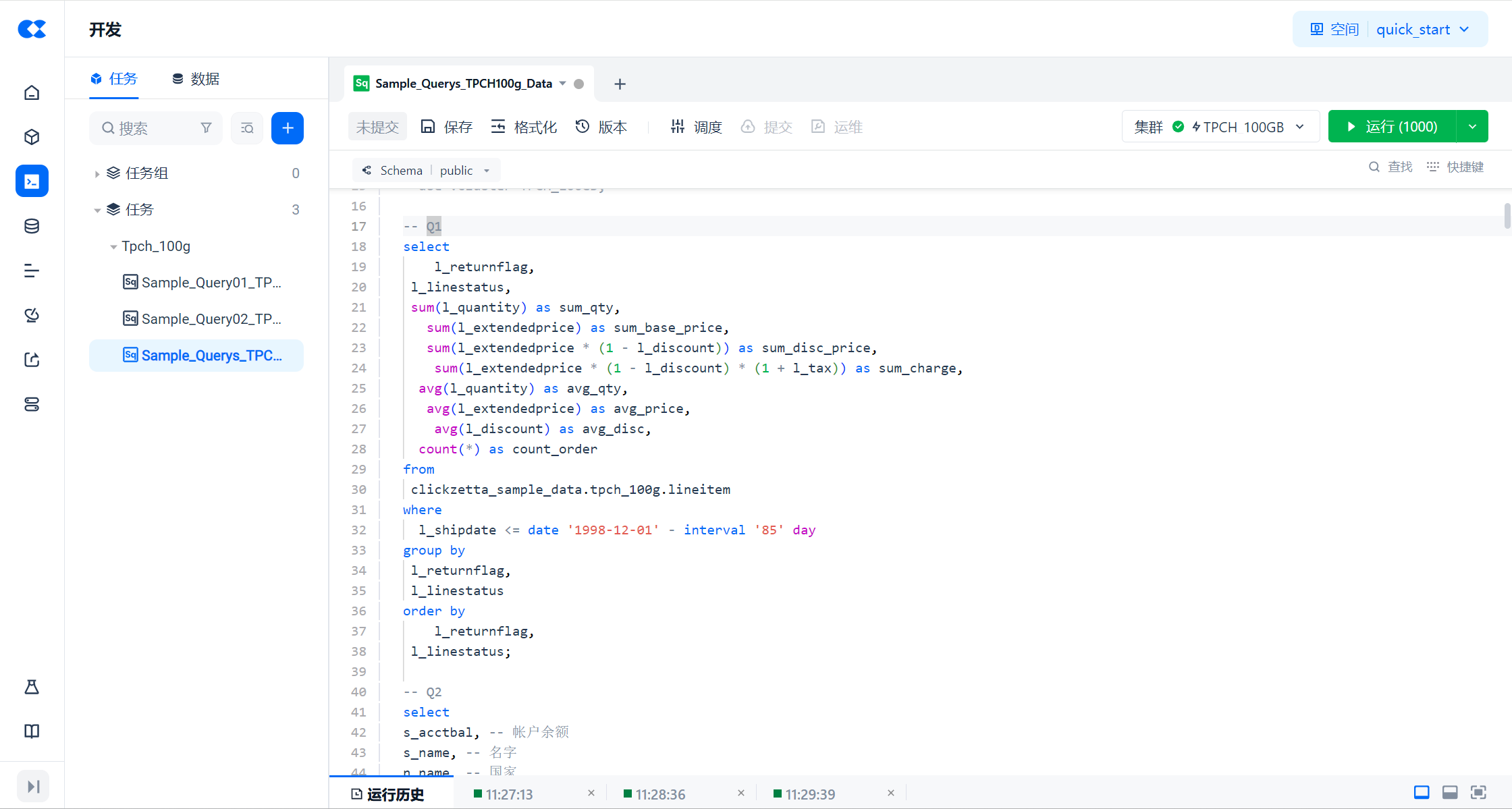
The query script is as follows:
-- Execute the job using TPCH_100GB computing resources
use vcluster TPCH_100GB;
-- Set the query tag
set query_tag='tpch100g_benchmark';
-- Q1
select
l_returnflag,
l_linestatus,
sum(l_quantity) as sum_qty,
sum(l_extendedprice) as sum_base_price,
sum(l_extendedprice * (1 - l_discount)) as sum_disc_price,
sum(l_extendedprice * (1 - l_discount) * (1 + l_tax)) as sum_charge,
avg(l_quantity) as avg_qty,
avg(l_extendedprice) as avg_price,
avg(l_discount) as avg_disc,
count(*) as count_order
from
clickzetta_sample_data.tpch_100g.lineitem
where
l_shipdate <= date '1998-12-01' - interval '85' day
group by
l_returnflag,
l_linestatus
order by
l_returnflag,
l_linestatus;
-- Q2
select
s_acctbal, -- Account balance
s_name, -- Name
n_name, -- Country
p_partkey, -- Part number
p_mfgr, -- Manufacturer
s_address, -- Supplier address
s_phone, -- Phone number
s_comment -- Comment
from
clickzetta_sample_data.tpch_100g.part,
clickzetta_sample_data.tpch_100g.supplier,
clickzetta_sample_data.tpch_100g.partsupp,
clickzetta_sample_data.tpch_100g.nation,
clickzetta_sample_data.tpch_100g.region
where
p_partkey = ps_partkey
and s_suppkey = ps_suppkey
and p_size = 15 -- Specified size, randomly chosen within the range [1, 50]
and p_type like '%BRASS' -- Specified type, randomly chosen within the range specified by TPC-H standard
and s_nationkey = n_nationkey
and n_regionkey = r_regionkey
and r_name = 'EUROPE' -- Specified region, randomly chosen within the range specified by TPC-H standard
and ps_supplycost = (
select
min(ps_supplycost) -- Aggregate function
from -- Overlapping tables with the parent query
clickzetta_sample_data.tpch_100g.partsupp,
clickzetta_sample_data.tpch_100g.supplier,
clickzetta_sample_data.tpch_100g.nation,
clickzetta_sample_data.tpch_100g.region
where
p_partkey = ps_partkey
and s_suppkey = ps_suppkey
and s_nationkey = n_nationkey
and n_regionkey = r_regionkey
and r_name = 'EUROPE'
)
order by
s_acctbal desc,
n_name,
s_name,
p_partkey
limit 100;
-- Q3
select
l_orderkey,
sum(l_extendedprice * (1 - l_discount)) as revenue, -- Potential revenue, aggregate operation
o_orderdate,
o_shippriority
from
clickzetta_sample_data.tpch_100g.customer,
clickzetta_sample_data.tpch_100g.orders,
clickzetta_sample_data.tpch_100g.lineitem
where
c_mktsegment = 'BUILDING' -- Randomly chosen within the range specified by TPC-H standard
and c_custkey = o_custkey
and l_orderkey = o_orderkey
and o_orderdate < '1995-03-15' -- Specified date range, randomly chosen within [1995-03-01, 1995-03-31]
and l_shipdate > '1995-03-15' -- Specified date range, randomly chosen within [1995-03-01, 1995-03-31]
group by
l_orderkey, -- Order identifier
o_orderdate, -- Order date
o_shippriority -- Shipping priority
order by
revenue desc, -- Descending order, placing the highest potential revenue at the top
o_orderdate
limit 10;
-- Q4
select
o_orderpriority,
count(*) as order_count
from
clickzetta_sample_data.tpch_100g.orders
where
o_orderdate >= date '1993-10-01'
and o_orderdate < date '1993-10-01' + interval '3' month
and exists (
select
*
from
clickzetta_sample_data.tpch_100g.lineitem
where
l_orderkey = o_orderkey
and l_commitdate < l_receiptdate
)
group by
o_orderpriority
order by
o_orderpriority;
-- Q5
select
n_name,
sum(l_extendedprice * (1 - l_discount)) as revenue
from
clickzetta_sample_data.tpch_100g.customer,
clickzetta_sample_data.tpch_100g.orders,
clickzetta_sample_data.tpch_100g.lineitem,
clickzetta_sample_data.tpch_100g.supplier,
clickzetta_sample_data.tpch_100g.nation,
clickzetta_sample_data.tpch_100g.region
where
c_custkey = o_custkey
and l_orderkey = o_orderkey
and l_suppkey = s_suppkey
and c_nationkey = s_nationkey
and s_nationkey = n_nationkey
and n_regionkey = r_regionkey
and r_name = 'ASIA' -- Specified region, randomly chosen within the range specified by TPC-H standard
and o_orderdate >= '1994-01-01' -- DATE is randomly chosen from a year between 1993 and 1997, January 1st
and o_orderdate < date '1996-01-01' + interval '1' year
group by
n_name -- Group by name
order by
revenue desc; -- Sort by revenue in descending order, note the difference between group and sort clauses
-- Q6
select
sum(l_extendedprice * l_discount) as revenue -- Potential revenue increase
from
clickzetta_sample_data.tpch_100g.lineitem
where
l_shipdate >= '1994-01-01' -- DATE is randomly chosen from a year between 1993 and 1997, January 1st
and l_shipdate < date '1996-01-01' + interval '1' year -- Within a year
and l_discount between 0.06 - 0.01 and 0.06 + 0.01
and l_quantity < 24; -- QUANTITY is randomly chosen within the range [24, 25]
-- Q7
select
supp_nation, -- Supplier nation
cust_nation, -- Customer nation
l_year,
sum(volume) as revenue -- Annual shipping revenue
from
(
select
n1.n_name as supp_nation,
n2.n_name as cust_nation,
extract(year from l_shipdate) as l_year,
l_extendedprice * (1 - l_discount) as volume
from
clickzetta_sample_data.tpch_100g.supplier,
clickzetta_sample_data.tpch_100g.lineitem,
clickzetta_sample_data.tpch_100g.orders,
clickzetta_sample_data.tpch_100g.customer,
clickzetta_sample_data.tpch_100g.nation n1,
clickzetta_sample_data.tpch_100g.nation n2
where
s_suppkey = l_suppkey
and o_orderkey = l_orderkey
and c_custkey = o_custkey
and s_nationkey = n1.n_nationkey
and c_nationkey = n2.n_nationkey
and ( -- Different values for NATION2 and NATION1, indicating cross-country shipping
(n1.n_name = 'FRANCE' and n2.n_name = 'GERMANY')
or (n1.n_name = 'GERMANY' and n2.n_name = 'FRANCE')
)
and l_shipdate between '1995-01-01' and '1996-12-31'
) as shipping
group by
supp_nation,
cust_nation,
l_year
order by
supp_nation,
cust_nation,
l_year;
-- Q8
select
o_year, -- Year
sum(case
when nation = 'BRAZIL' then volume -- Specified country, randomly chosen within the range specified by TPC-H standard
else 0
end) / sum(volume) as mkt_share -- Market share: percentage of revenue from a specific type of product; aggregate operation
from
(
select
extract(year from o_orderdate) as o_year, -- Extract year
l_extendedprice * (1 - l_discount) as volume, -- Revenue from a specific type of product
n2.n_name as nation
from
clickzetta_sample_data.tpch_100g.part,
clickzetta_sample_data.tpch_100g
After execution, you can view the runtime of this task through the current SQL Editor's execution history.

If you want to perform performance testing, you can execute the query more than twice consecutively so that the computing cluster can fully cache the data for optimal performance. At the same time, Singdata Lakehouse also provides an active system caching feature, which is not covered in this tutorial. Below is the result of the second run, showing the performance improvement after the computing cluster caches the data compared to the first run without caching.

If you want to see the execution details of each of the 22 queries, you can access "Compute → Job History" and filter the query history by the query tag "tpch100g_benchmark".

## Step3. Expand the cluster size and query the sample data with TPC-H again
Through the "Compute → Cluster" management page, you can modify the size of the test cluster you just created from M to L, where the L size is twice that of M.

Or execute the following command in the SQL script to modify:
```sql
-- Modify cluster size
alter vcluster TPCH_100GB SET VCLUSTER_SIZE = 'LARGE';
After modification, use the resized cluster to perform the query test again.
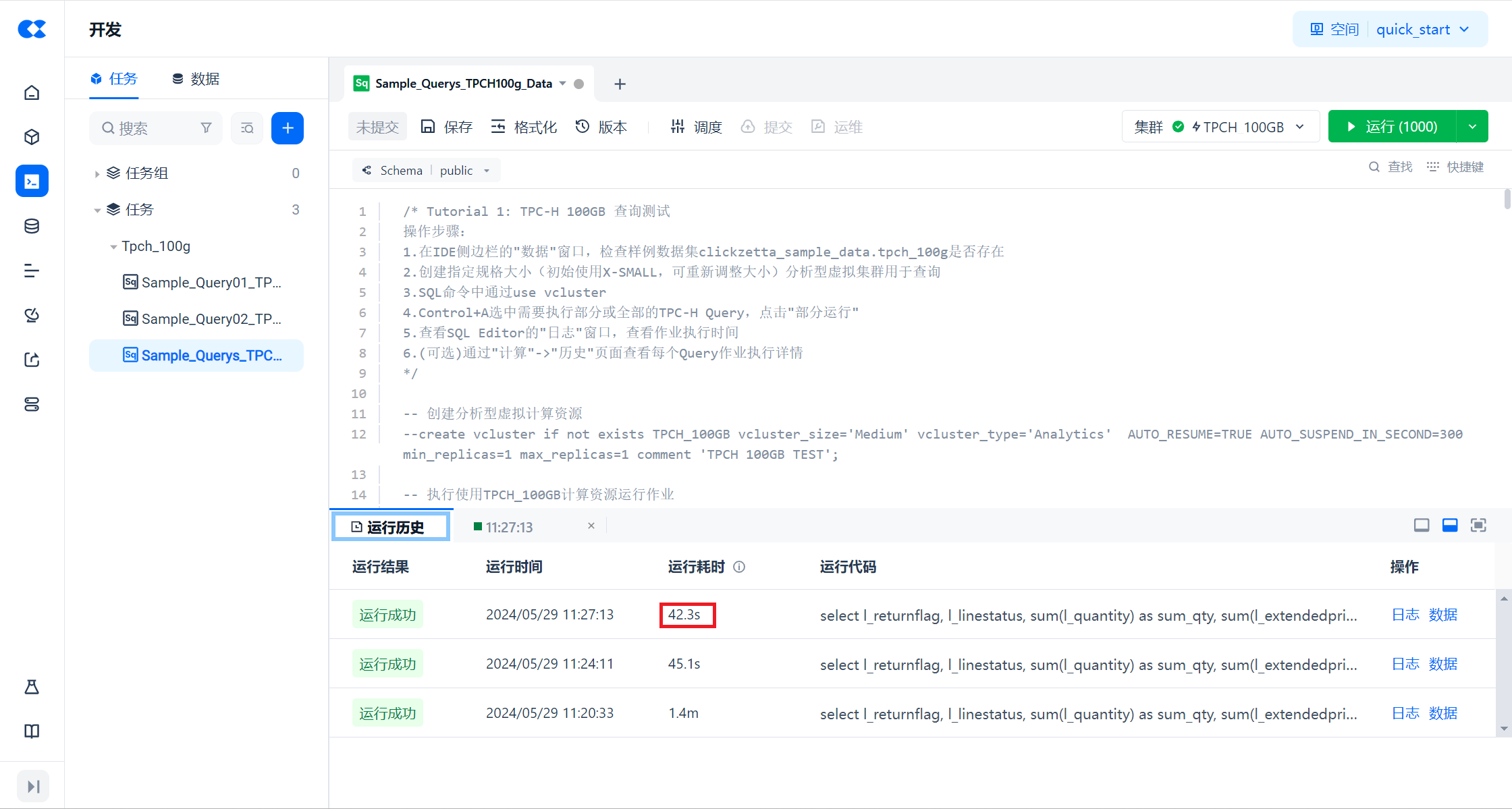
After the new computing nodes are fully cached, the performance will continue to improve.
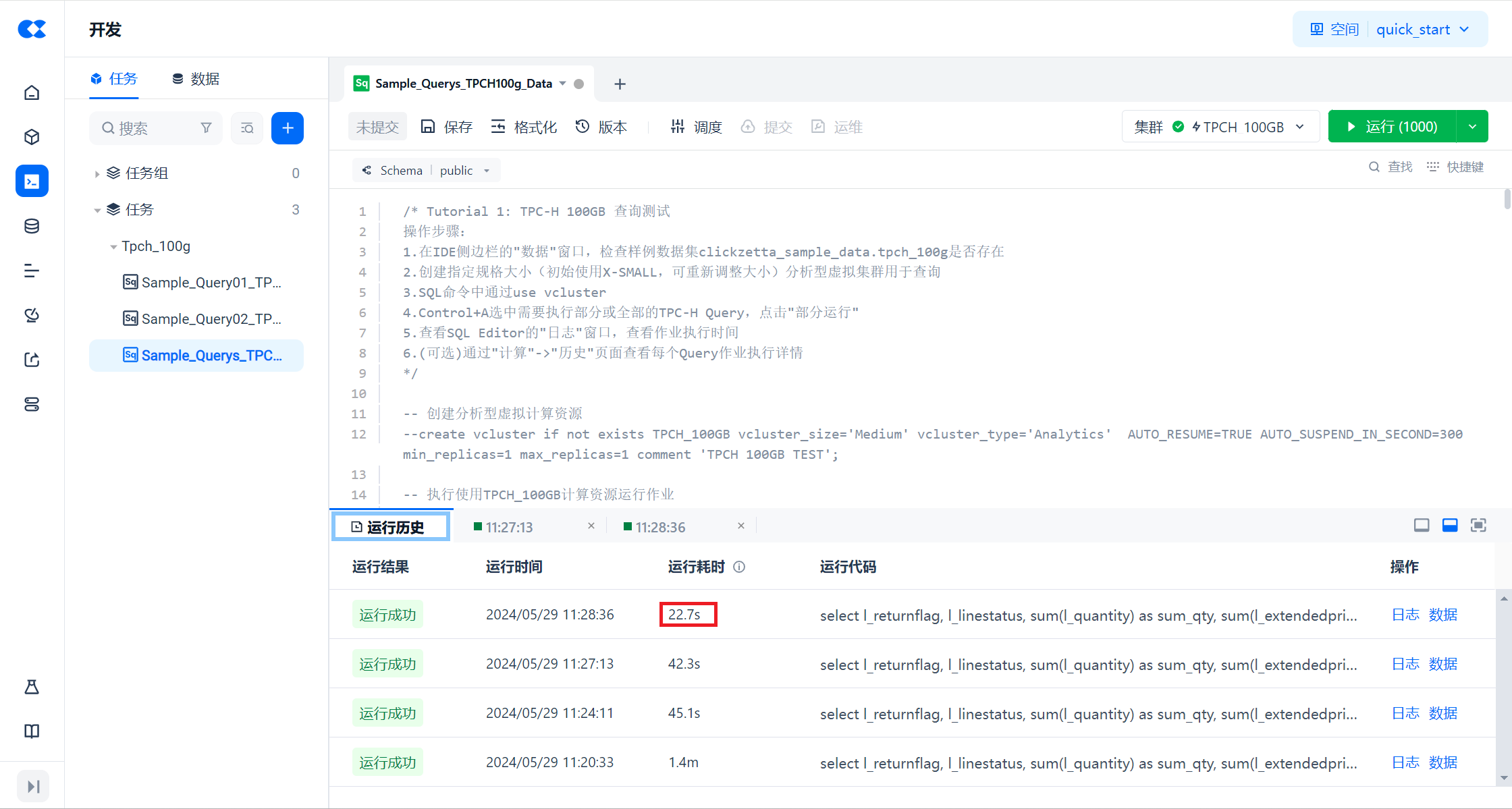
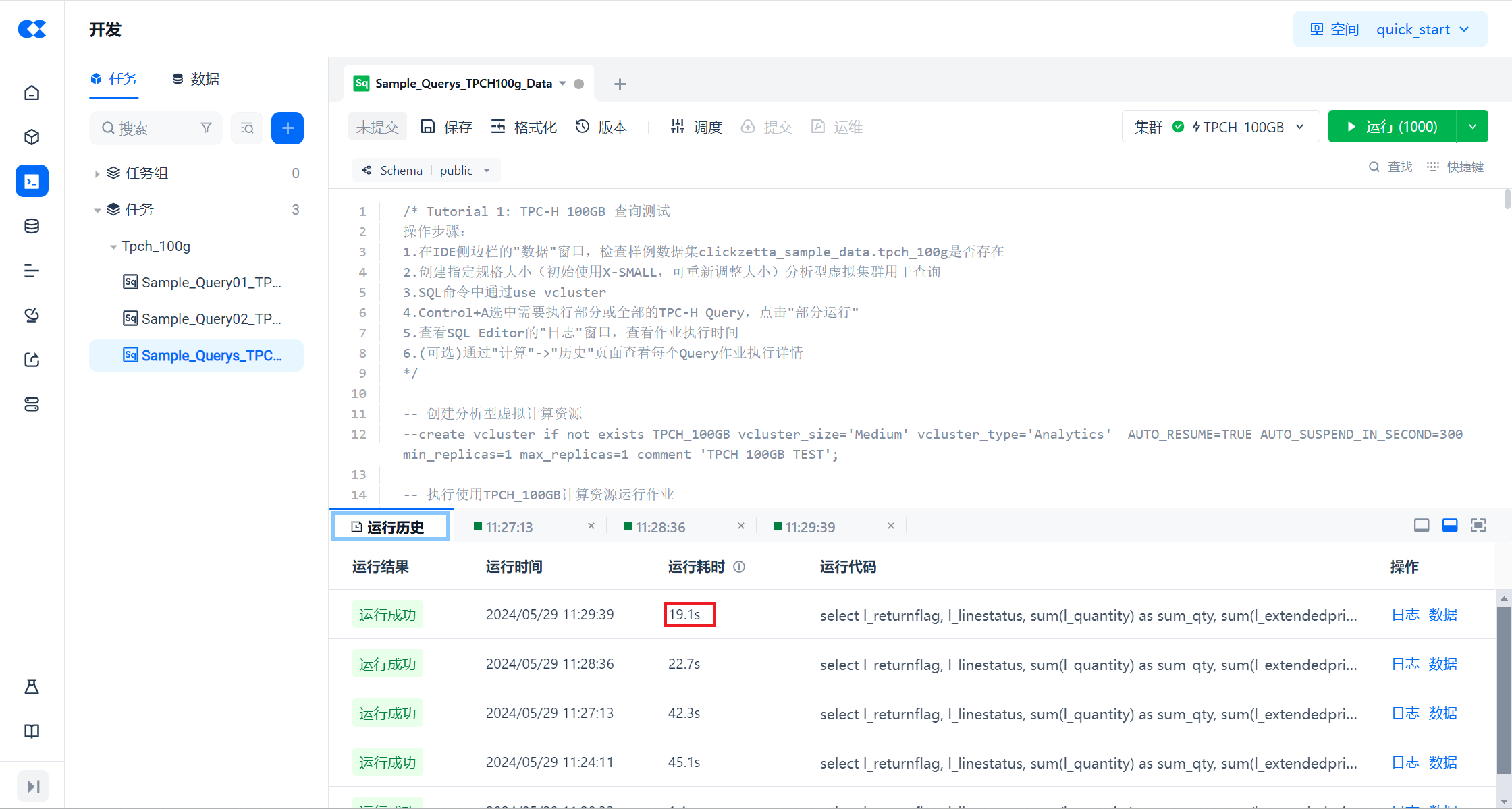
By observing the running time of the job, it can be seen that with the same data scale and query tasks, the overall running time of the task is greatly reduced by expanding the size of the computing cluster. After two executions, as the data is cached, query performance can be improved.







